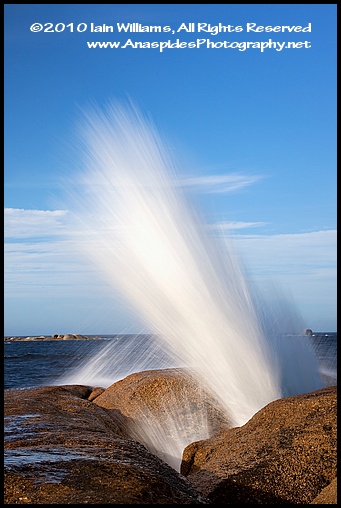 I'd decided before departing for New Zealand that I was keen to acquire images of albatross in flight and at sea. I was particularly interested in obtaining flight shots of the Wandering Albatross (Diomededea exulans), which is the largest albatross in the albatross family.
I'd decided before departing for New Zealand that I was keen to acquire images of albatross in flight and at sea. I was particularly interested in obtaining flight shots of the Wandering Albatross (Diomededea exulans), which is the largest albatross in the albatross family.
LEFT: Wandering Albatross (Diomededea exulans) flying in to land.
To achieve this I secured an arrangement to use a boat operated by Dolphin Encounters based in Kaikoura. Unfortunately for me the first day was exceptionally rough and I was soon quite seasick; at one stage there were waves washing over the bow of the boat and flowing across the windscreen! Add to this, the optical distress of looking through a long lens in a rocking boat, and you can imagine the reasons why I felt ill for much of the time at sea. I managed to get in about an hour of shooting before I too was feeding the albatross…
Although I was ill, I did manage to see several species of albatross including the wandering albatross. My first sighting of the wandering albatross was spectacular! As the boat rose and fell to the rhythm of the ocean swell, I saw this massive bird, not flying, but gliding along the crests and troughs of the waves. The bird would glide for what seemed eternity before eventually arcing skywards to alter direction and make another flight run. I was reminded of a surfer working his way along the front of a large wave to eventually flick himself upwards and over the crest.
Albatross are exceptionally graceful when in flight, however, as they approach to land, this gracefulness changes to abstract horror as they loose airspeed and subsequent lift, almost performing a managed crash landing. It seems that the larger the albatross the worse the landing!
The wing span of the Wandering Albatross is between 8 and 12 feet in length and it’s because of this immense wing span, and subsequent lift, that this bird is capable of staying in the air for several hours without flapping its wings. Interestingly, this species of albatross is typically a night feeder and its diet consists of cephalopods, crustaceans and animal refuse floating on the surface of the ocean.
 Long Lining
Long Lining
It’s very disturbing that this species, along with many other species of albatross are subject to global decline due to poor fishing practices – especially long lining. Long lines are set by fisherman in an attempt to increase the catch of target fish, usually swordfish, Patagonian tooth fish and tuna. These lines can be up to ~80 miles (~140 kilometers) in length and float just beneath the surface of the ocean. Each line is armed with thousands of sharp hooks, each baited with fish or squid. The bait on these lines attracts albatross and other seabirds which dive to capture the tasty morsel and become “hooked”. Unfortunately, once an albatross or other seabird is hooked, it isn’t able to reach the surface and they suffocate and die an agonizing death!
LEFT: Please note that this image is courtesy of G. Robertson, Australian Antarctica Division, Tasmania (with thanks)
It’s been reliably recorded that ~100,000 albatrosses die each year on fishing hooks. The long lines are killing so many birds that in many circumstances recruitment is not replacing those killed! The possibility of extinction is high.
Birdlife International has compiled a list of threatened birds. Currently, three albatross species are Critically Endangered, seven are Endangered and nine are Vulnerable. 19 of the 22 species of albatross in the world are threatened with extinction largely because of long line fishing.
This is a sobering thought when you realize that many people have absolutely no idea of the plight of the albatross. Very few people actually see albatrosses because they spend much of their time either at sea or at nesting sites well away from mainland populations.
The Wandering Albatross is listed as vulnerable in the IUCN Red List.
 Sunday, April 4, 2010 at 8:12PM
Sunday, April 4, 2010 at 8:12PM 

 Australia,
Australia,  Cement,
Cement,  Engineering,
Engineering,  Form,
Form,  Structure,
Structure,  Tasman Bridge,
Tasman Bridge,  Tasmania in
Tasmania in  Tasmania Australia
Tasmania Australia 








